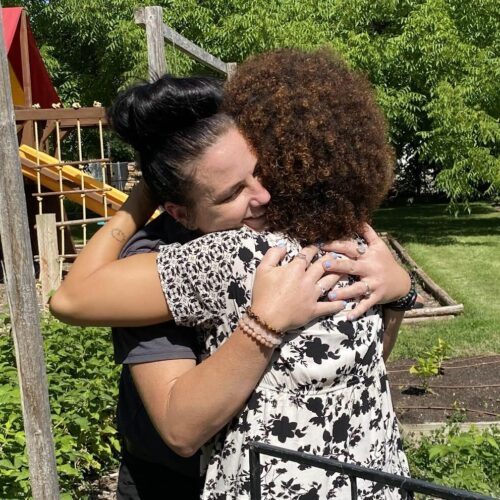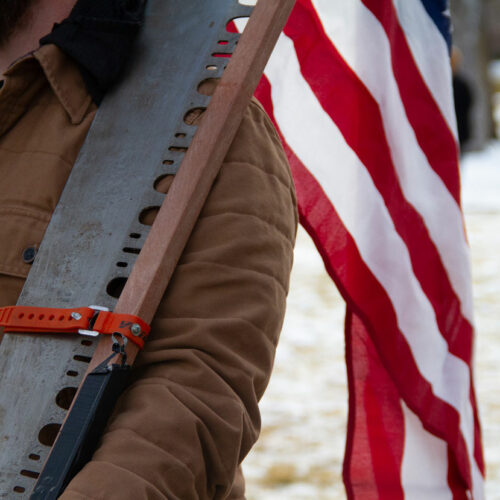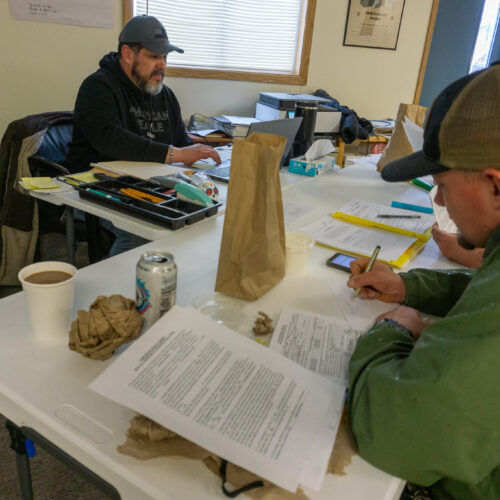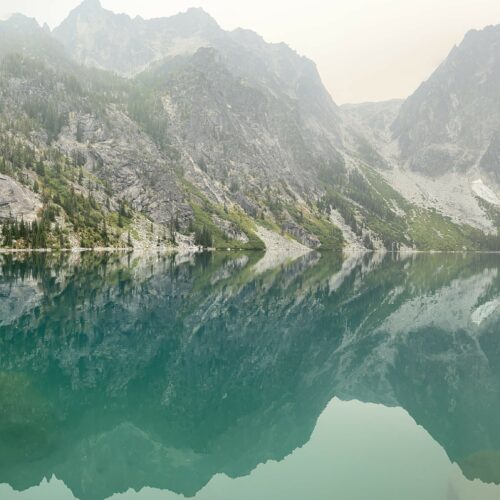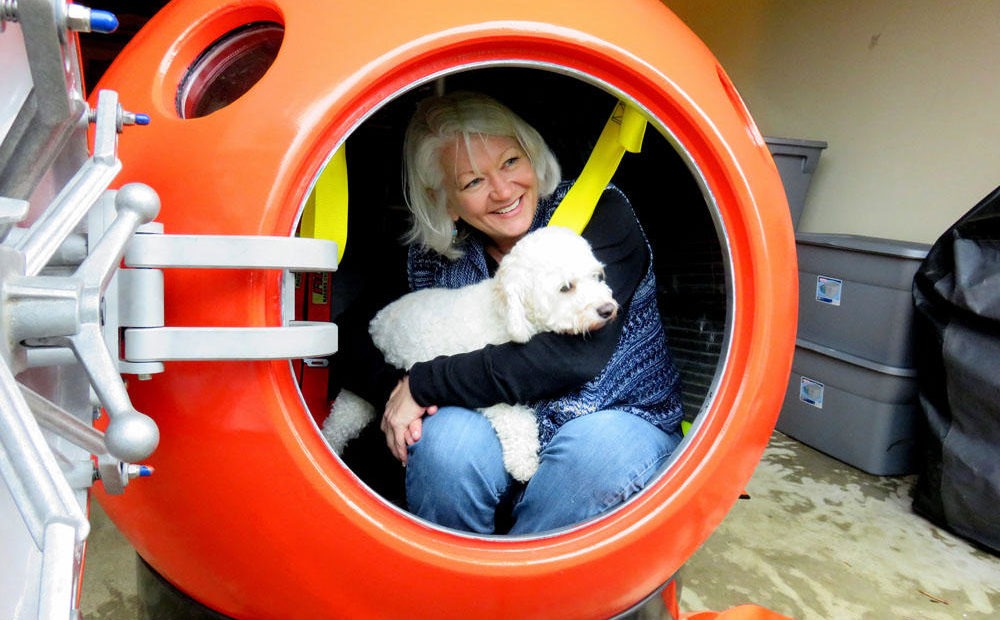
First Tsunami Survival Capsule Deployed On Pacific Northwest Coast
A new tsunami survival option has come to the Pacific Northwest coast. It involves climbing into a spherical aluminum pod for what is sure to be the ride of your life.
The first U.S. buyer of this technology resides in Ocean Park, Washington. Jeanne Johnson just recently moved from the Seattle area to what she calls her “dream home” at the beach. It’s about midway up the sandy, flat Long Beach Peninsula.
“When I decided to move to the ocean into a tsunami zone I felt like I should prepare,” Johnson said.
Her tsunami evacuation options are not good. She could make a run for it, but this Microsoft executive doubts she could reach the distant high ground in the short time
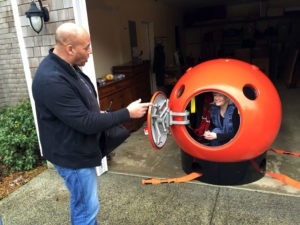
Survival Capsule President Julian Sharpe gives some tips to his first domestic U.S. customer Jeanne Johnson.
between the end of the shaking of a great earthquake and incoming tsunami waves.
“People panic and I don’t want to be caught in the panic,” Johnson said.
‘What’s my option? To drown?’
A bit of internet research led her to a new option: a survival capsule — a bright orange, high-strength floating metal ball. She has taken delivery and is now deciding whether to tether her capsule in her herb garden or keep it in the garage. In any case, Johnson wants her dog to join her if and when “the Big One” comes.
“My model is big enough for two people to be buckled in like a pilot’s seat,” she said.
The aircraft-grade aluminum sphere is about four-and-a-half feet in diameter. The sphere looks a little bit like an astronaut capsule. It has a round marine door and two tiny portholes.
The survival capsule delivered to Johnson Wednesday came equipped with twin air tanks inside in case the capsule is pinned underwater for a time or is surrounded by burning debris. The aluminum shell of the capsule has a ceramic blanket interior lining to protect against the heat of fire on the outside. A welded tubular framework inside braces the exterior shell. There are drinking water
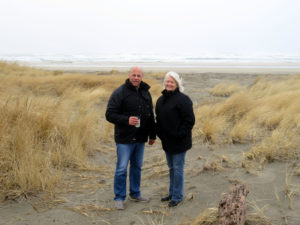
Survival Capsule customer Jeanne Johnson, right, lives three houses in from the dunes and the Pacific Ocean surf on Washington’s Long Beach Peninsula. Geologic records show the Cascadia Subduction Zone offshore is capable of generating a massive tsunami.
bladders in the bottom of the capsule and a GPS locator beacon in the event the capsule goes adrift.
“I have friends who say, ‘Oh my God, wouldn’t it be claustrophobic? How can you stand it?’ All I can think is, what’s my option? To drown? I would rather be in that ball for the ride of my life and maintain my life.”
‘Throw the family in and ride it out’
Johnson is the first domestic customer of a startup called Survival Capsule, based near Seattle. Company president Julian Sharpe said he got the idea for the product lying awake one night while weekending in Cannon Beach, Oregon.
“I thought, ‘Well, what happens now if a tsunami comes?’” Sharpe said.
The aerospace engineer had a brainstorm.
“I just thought it’s going to be a disaster because I’ve got four sleeping kids,” Sharpe said. “If it comes at night, the lights are going to be out. You don’t necessarily know where you’re going. You can’t see the wave, how far it is. So I thought it would be great if I could design something to throw the family in and ride it out. That’s where it all started.”
Sharpe’s company’s initial sales have been to Japanese customers — eight capsule kits so far. He anticipates local governments in Japan could become a major customer base along with private sales along the U.S. West Coast, Gulf Coast and East Coast.
“The target customer is the person who lives on the ocean who cannot vertically or horizontally evacuate,” Sharpe said.
Survival… at a cost
That’s potentially a lot of people as long as they’re willing to pay the price. Sharpe says the two-person survival capsule starts at $13,500. A four-person model lists for $17,500. Six, eight and ten-person models are for sale as well.
Sharpe said he aspires to bring the price down through economies of scale when orders increase.
“We hope that people will see the value of this product,” he said. “It’s not a gizmo or a toy. It’s a life insurance policy. It’s really designed to give people who live in coastal communities peace of mind.”
Sharpe and Johnson hope the government will eventually subsidize private purchases of the survival capsules as an extension of public spending on tsunami readiness projects such as the planned safe haven berm proposed for a field behind Long Beach Elementary School.
While the inspiration for the product was tsunami survival, Sharpe said his company’s capsules are now drawing additional interest from coastal residents worried about hurricanes.
“Rather than evacuate from hurricanes and be 200 miles away while the hurricane decides it wants to go in a different direction leaving their home vulnerable — or business vulnerable — to looting, they want to stay at home and have a tsunami capsule as a last line of defense,” Sharpe explained.
Mixed reactions
Residents who swung by Long Beach City Hall earlier to look at plans for a different evacuation option had mixed reactions to the tsunami capsule idea. Jane Bena shivered at the prospect of sheltering inside while being battered by tsunami debris.
“I would hate to be bounced around in that,” she said. “I’m too old. I’m 80 years old. I don’t know that I would care to survive a tsunami.”
The City of Long Beach, Washington, is using grant money to design an armored, manmade hill that could be used as a tsunami evacuation platform for at least 850 people. Bena favors building this, but as you maybe can tell she’s fatalistic about her own chances.


